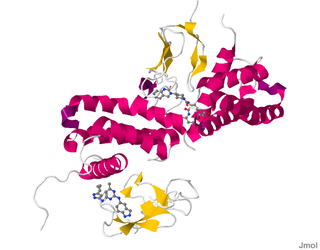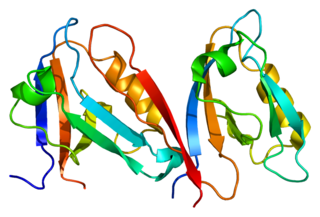
Erbb2 interacting protein (ERBB2IP), also known as erbin, is a protein which in humans is encoded by the ERBB2IP gene. Discovered in 1997, erbin is a 200kDa protein containing a PDZ domain.

PSD-95 also known as SAP-90 is a protein that in humans is encoded by the DLG4 gene.

POU domain, class 2, transcription factor 1 is a protein that in humans is encoded by the POU2F1 gene.

Calcitonin receptor-like (CALCRL), also known as the calcitonin receptor-like receptor (CRLR), is a human protein; it is a receptor for calcitonin gene-related peptide.

AP-2 complex subunit alpha-1 is a protein that in humans is encoded by the AP2A1 gene.

Growth arrest – specific 6, also known as GAS6, is a human gene coding for the GAS6 protein. It is similar to the Protein S with the same domain organization and 43% amino acid identity. It was originally found as a gene upregulated by growth arrested fibroblasts.

Alpha-actinin-1 is a protein that in humans is encoded by the ACTN1 gene.

Guanine nucleotide-binding protein G(I)/G(S)/G(T) subunit beta-1 is a protein that in humans is encoded by the GNB1 gene.

5'-AMP-activated protein kinase catalytic subunit alpha-1 is an enzyme that in humans is encoded by the PRKAA1 gene.

Tyrosine-protein phosphatase non-receptor type 13 is an enzyme that in humans is encoded by the PTPN13 gene.

Rho guanine nucleotide exchange factor 7 is a protein that in humans is encoded by the ARHGEF7 gene.

Alpha-1-syntrophin is a protein that in humans is encoded by the SNTA1 gene. Alpha-1 syntrophin is a signal transducing adaptor protein and serves as a scaffold for various signaling molecules. Alpha-1 syntrophin contains a PDZ domain, two Pleckstrin homology domain and a 'syntrophin unique' domain.

Amyloid beta A4 precursor protein-binding family A member 2 is a protein that in humans is encoded by the APBA2 gene.

Plexin B1 is a protein of the plexin family that in humans is encoded by the PLXNB1 gene.

Serine/threonine-protein kinase N2 is an enzyme that in humans and Strongylocentrotus purpuratus is encoded by the PKN2 gene.

InaD-like protein is a protein that in humans is encoded by the PATJ gene.

Lin-7 homolog A is a protein that in humans is encoded by the LIN7A gene.

RalBP1-associated Eps domain-containing protein 2 is a protein that in humans is encoded by the REPS2 gene.

Guanine nucleotide-binding protein subunit alpha-11 is a protein that in humans is encoded by the GNA11 gene. Together with GNAQ, it functions as a Gq alpha subunit.

Ryanodine receptor 3 is one of a class of ryanodine receptors and a protein that in humans is encoded by the RYR3 gene. The protein encoded by this gene is both a calcium channel and a receptor for the plant alkaloid ryanodine. RYR3 and RYR1 control the resting calcium ion concentration in skeletal muscle.


































